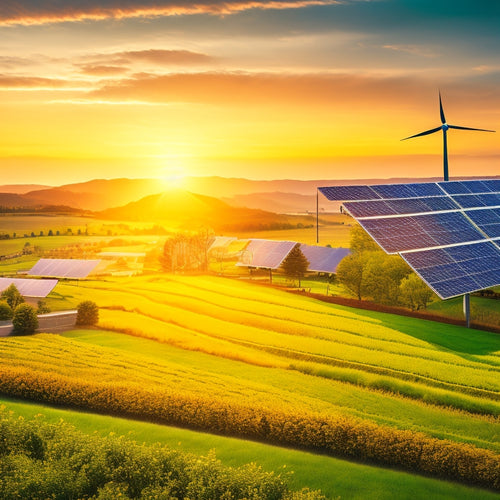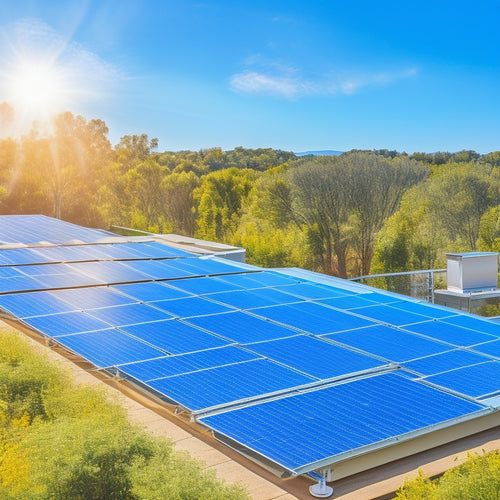
What Makes a Great Off-Grid Energy System?
Share
When designing an off-grid energy system, you need to carefully consider five important components to efficiently capture, store, and distribute energy to meet your daily needs. You'll need to assess your energy requirements, choosing the right solar panels that provide ideal energy output, and sizing your battery bank to guarantee consistent power supply. Selecting the proper inverter and charge controller is also essential, as is establishing a maintenance routine to prevent downtime. By focusing on these fundamental elements, you'll be well on your way to creating a reliable and sustainable off-grid energy system that meets your unique needs, and understanding these details will be key to your success.
Overview
- A great off-grid energy system accurately assesses daily energy needs and prioritizes essential devices for efficient resource allocation.
- High-efficiency solar panels with long-term warranties and eco-friendly materials ensure optimal energy output and minimal environmental impact.
- Properly sized battery banks with suitable chemistry and discharge rates provide reliable energy storage and backup.
- Selecting the right inverter and charge controller ensures efficient energy conversion and regulation, aligning with specific appliance needs.
- Regular system monitoring and maintenance schedules prevent downtime, identify potential issues early, and maximize system lifespan.
Assessing Your Energy Needs
You'll need to determine how much energy your off-grid system must produce to meet your daily needs. Evaluating your energy consumption is vital to designing a reliable and efficient system.
Start by tracking your energy usage patterns, including the appliances and devices you use, their wattage, and the hours of operation. Consider your lifestyle choices, such as how many hours of lighting and computing you need per day.
For instance, prioritizing energy needs focusing on essential devices will help you allocate resources more effectively. Additionally, designing your system for efficiency and sustainability will guarantee a consistent energy supply.
Calculate your total daily energy requirements in watt-hours (Wh) to determine the minimum capacity of your off-grid system. This will help you size your solar array, battery bank, and inverter correctly, ensuring you have a consistent and sustainable energy supply.
Choosing the Right Solar Panels
Every off-grid energy system relies on a well-designed solar panel array to capture renewable energy from the sun. When choosing the right solar panels for your system, you'll need to take into account several factors.
First, you'll need to decide between monocrystalline, polycrystalline, and thin-film solar panel types, each with their own efficiency ratings and cost comparisons. Look for high-efficiency ratings (above 20%) for maximum energy output, and take into account panels with durable constructions that can withstand harsh environmental conditions.
Review warranty options, aiming for coverage of performance, materials, and workmanship for at least 25 years. During installation, verify panels are angled correctly and securely fastened to withstand environmental stressors.
Warranty considerations are also significant, with reputable manufacturers offering 25-year warranties. Reflect on the environmental impact of your choice, opting for panels with minimal waste and recyclable materials.
Sizing Your Battery Bank
Sizing your battery bank is a critical component in designing an off-grid energy system, as it directly affects the system's overall performance and reliability.
You'll need to take into account your energy requirements, battery chemistry, and discharge rates to determine the ideal size of your bank. When selecting a battery brand, look for top-rated solar battery brands that offer extensive warranty options and high-quality products that can withstand environmental challenges.
Calculate your daily energy needs in watt-hours, then factor in your desired days of autonomy and the depth of discharge (DOD) you're comfortable with. For example, if you need 2,000 watt-hours daily and want three days of autonomy with a 50% DOD, you'll need a battery bank with a capacity of around 12,000 watt-hours.
Inverter and Charge Controller Selection
Now that your battery bank is sized to meet your energy needs, it's time to focus on converting and regulating that energy.
You'll need an inverter to convert DC power from your battery bank to AC power for your appliances. There are several inverter types to take into account, including modified sine wave, pure sine wave, and grid-tie inverters. Each has its advantages and disadvantages, so choose carefully based on your specific needs.
A charge controller is also essential, as it regulates the flow of energy from your renewable energy source to your battery bank.
There are various charge controller technologies available, including PWM, MPPT, and shunt controllers. Reflect on factors like efficiency, flexibility, and compatibility when selecting a charge controller.
System Monitoring and Maintenance
Your off-grid energy system's performance and longevity rely heavily on effective system monitoring and maintenance. You need to keep a close eye on your system's performance to guarantee it's operating within ideal parameters. This involves tracking key metrics like voltage, current, and temperature to identify potential issues before they become major problems.
Establishing regular maintenance schedules is vital to prevent system downtime and reduce wear and tear on components. By monitoring your system's performance and sticking to a routine maintenance schedule, you'll be able to identify and address any issues promptly, assuring your system runs efficiently and effectively.
This proactive approach will help you maximize your system's lifespan and minimize unnecessary repairs.
Frequently Asked Questions
Can I Use a Generator as a Backup Power Source for My Off-Grid System?
You can use a generator as a backup power source, choosing from types like inverter, conventional, or Generac, and fuel options like gasoline, propane, or diesel, ensuring reliable energy supply when your off-grid system needs it.
How Do I Protect My System From Lightning Strikes and Power Surges?
You're about to release a storm of independence, but first, safeguard your off-grid haven from Mother Nature's fury by installing lightning rods and surge protectors to shield your system from devastating strikes and power surges.
Can I Install an Off-Grid System Myself or Do I Need a Professional?
You can attempt a DIY installation, but considering the complexity and safety considerations, it's often recommended that you hire a professional to guarantee a safe and efficient off-grid energy system that meets your specific needs.
How Long Does It Take to Install a Complete Off-Grid Energy System?
You'll typically spend 2-5 days on installation, but this timeline varies depending on system components and complexity; a professional can provide a more accurate estimate, considering factors like roof size, battery bank configuration, and electrical infrastructure.
Are Off-Grid Energy Systems Compatible With Electric Vehicle Charging?
As you cruise into the sunset in your EV, you'll wonder if your off-grid energy system can keep up; have confidence, solar compatibility and sufficient battery capacity guarantee seamless charging, giving you the freedom to roam wherever the road takes you.
Ready to Buy
You've maneuvered the intricacies of off-grid energy systems, and now you're ready to utilize the power of the sun. You've assessed your energy needs, chosen the right solar panels, sized your battery bank, selected the perfect inverter and charge controller, and set up system monitoring and maintenance. With these components in harmony, you'll enjoy reliable, efficient, and sustainable energy. Your off-grid system will thrive, and so will you - free from the grid, yet connected to the world.
Related Posts
-

Net Metering in Renewable Energy's Future
Net metering's future is vital for driving renewable energy growth and financial savings. You can reduce your electri...
-

What Types of Solar Energy Devices Are Available
You'll find several types of solar energy devices available today, each customized to different energy needs. Photovo...
-

Designing a Green Roof for Maximum Energy Efficiency
Designing a green roof for maximum energy efficiency involves several key strategies. Start by selecting native, drou...


